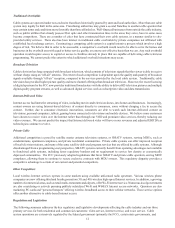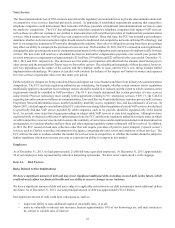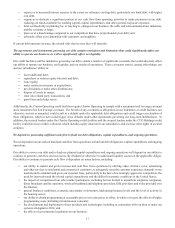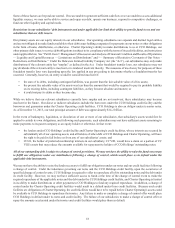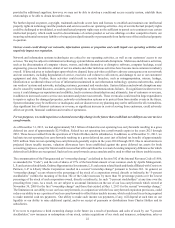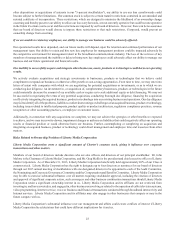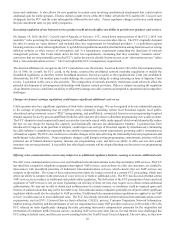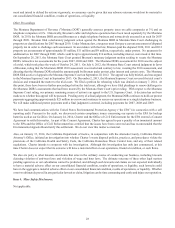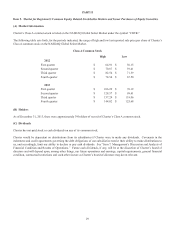Charter 2013 Annual Report Download - page 35
Download and view the complete annual report
Please find page 35 of the 2013 Charter annual report below. You can navigate through the pages in the report by either clicking on the pages listed below, or by using the keyword search tool below to find specific information within the annual report.21
We may not have the ability to reduce the high growth rates of, or pass on to our customers, our increasing programming costs,
which would adversely affect our cash flow and operating margins.
Programming has been, and is expected to continue to be, our largest operating expense item. In recent years, the cable industry
has experienced a rapid escalation in the cost of programming. We expect programming costs to continue to increase because of
a variety of factors including amounts paid for retransmission consent, annual increases imposed by programmers with additional
selling power as a result of media consolidation, additional programming, including new sports services and non-linear
programming for on-line and OnDemand platforms. The inability to fully pass these programming cost increases on to our
customers has had an adverse impact on our cash flow and operating margins associated with the video product. We have
programming contracts that have expired and others that will expire at or before the end of 2014. There can be no assurance that
these agreements will be renewed on favorable or comparable terms. To the extent that we are unable to reach agreement with
certain programmers on terms that we believe are reasonable, we may be forced to remove such programming channels from our
line-up, which could result in a further loss of customers.
Increased demands by owners of some broadcast stations for carriage of other services or payments to those broadcasters for
retransmission consent are likely to further increase our programming costs. Federal law allows commercial television broadcast
stations to make an election between “must-carry” rights and an alternative “retransmission-consent” regime. When a station opts
for the latter, cable operators are not allowed to carry the station’s signal without the station’s permission. In some cases, we carry
stations under short-term arrangements while we attempt to negotiate new long-term retransmission agreements. If negotiations
with these programmers prove unsuccessful, they could require us to cease carrying their signals, possibly for an indefinite period.
Any loss of stations could make our video service less attractive to customers, which could result in less subscription and advertising
revenue. In retransmission-consent negotiations, broadcasters often condition consent with respect to one station on carriage of
one or more other stations or programming services in which they or their affiliates have an interest. Carriage of these other
services, as well as increased fees for retransmission rights, may increase our programming expenses and diminish the amount of
capacity we have available to introduce new services, which could have an adverse effect on our business and financial results.
Our inability to respond to technological developments and meet customer demand for new products and services could limit
our ability to compete effectively.
Our business is characterized by rapid technological change and the introduction of new products and services, some of which
are bandwidth-intensive. We may not be able to fund the capital expenditures necessary to keep pace with technological
developments, execute the plans to do so, or anticipate the demand of our customers for products and services requiring new
technology or bandwidth. The testing and implementation of our network-based user interface may ultimately be unsuccessful
or more expensive than anticipated. The completion of our plan to become all-digital in 2014 could be delayed or cost more than
the anticipated $400 million in our 2014 plan. Our inability to maintain and expand our upgraded systems including through the
completion of our all-digital plan and provide advanced services such as a state of the art user interface in a timely manner, or to
anticipate the demands of the marketplace, could materially adversely affect our ability to attract and retain customers.
Consequently, our growth, financial condition and results of operations could suffer materially.
We depend on third party service providers, suppliers and licensors; thus, if we are unable to procure the necessary services,
equipment, software or licenses on reasonable terms and on a timely basis, our ability to offer services could be impaired, and
our growth, operations, business, financial results and financial condition could be materially adversely affected.
We depend on third party service providers, suppliers and licensors to supply some of the services, hardware, software and
operational support necessary to provide some of our services. We obtain these materials from a limited number of vendors, some
of which do not have a long operating history or which may not be able to continue to supply the equipment and services we
desire. Some of our hardware, software and operational support vendors, and service providers represent our sole source of supply
or have, either through contract or as a result of intellectual property rights, a position of some exclusivity. If demand exceeds
these vendors’ capacity or if these vendors experience operating or financial difficulties, or are otherwise unable to provide the
equipment or services we need in a timely manner, at our specifications and at reasonable prices, our ability to provide some
services might be materially adversely affected, or the need to procure or develop alternative sources of the affected materials or
services might delay our ability to serve our customers. These events could materially and adversely affect our ability to retain
and attract customers, and have a material negative impact on our operations, business, financial results and financial condition.
A limited number of vendors of key technologies can lead to less product innovation and higher costs. Our cable systems have
historically been restricted to using one of two proprietary conditional access security systems, which we believe has limited the
number of manufacturers producing set-top boxes for such systems. As an alternative, under a waiver granted to Charter by the
FCC, Charter is currently developing a conditional access security system which may be downloaded into set-top boxes provided
by a variety of manufacturers. We believe this new security system will make Charter systems more suitable for set-top boxes



